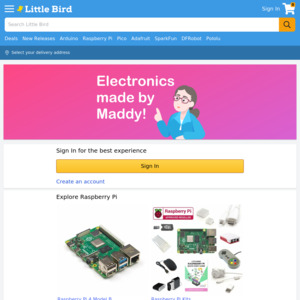After seeing the Wacome Intuos Tablet deal published earlier, I thought I'd share this alternative use of the same voucher system. You can get the voucher here
Little Bird Electronics offers 2 choices to redeem the voucher on for kids to get started with coding. As well as receiving a fair amount of good physical kit, there is access to numerous tutorials specific to the kit contents.
What is Micro:Bit?
The Micro:bit V2 is a pocket-sized computer that introduces you to how software and hardware work together. It has an LED light display, buttons, sensors and many input/output features that you can program and physically interact with. The latest micro:bit adds sound sensing and playback capabilities.
What is Arduino?
The Uno R3 is a microcontroller board based on the ATmega328 chip from MicroChip. It has 14 digital input/output pins (of which 6 can be used as PWM outputs), 6 analogue inputs, a 16 MHz crystal oscillator, a USB Type B connection, a DC Power Jack, an ICSP header, and a reset button.
Not sure which to choose?
Micro:bit offers more ease of use and quality of life features so is better suited for first timers. You can code it with C++, MakeCode, Python, Scratch and use iOS apps through Bluetooth. It already has a few sensors, buttons and LEDs built in compared to the Arduino which will need these things attached separately. Micro:bit is also 32-bit vs Arduino 8-bit which may or may not matter depending on what you intend to do with it.
Side by side contents comparison
| Micro:bit Kit | Arduino Coding Kit |
|---|---|
| Micro:bit V2 with built in speaker & microphone | Little Bird Uno R3 + USB Cable |
| GPIO expansion board | Breadboard |
| Battery pack | Jumper Wires |
| 2 x AAA batteries | LEDs (Multicolour RGB and single colours) |
| Micro USB cable | Temperature Sensor |
| 20 LEDs | Push Buttons |
| Resistor Pack (200ohm & 10K) | Potentiometer |
| Potentiometer Module | Buzzer |
| Temperature and Humidity Sensor Module | Servo |
| Tilt sensor | Sound Sensor |
| Hall effect sensor | IR Sensor |
| 4 Digit Display | IR Transmittor |
| Two Colour LED module | IR Remote |
| LDR | Tilt Sensor |
| Protective cover (random colour) | Temperature and Humidity Sensor |
| 400 Point Breadboard | Relay Actuator |
| Premium Jumper wires | Moisture Sensor |
| Aligator Clips | Hall Effect Sensor (for detecting magnetic fields) |
| Alcohol Sensor | |
| Touch Sensor | |
| Light Sensor | |
| Reed Switch | |
| Flame Sensor | |
| Plastic Case | |
| … and more! |
![[NSW] Free Micro:Bit Kit or Arduino Coding Kit (with Creative Kids Voucher) Delivered @ Little Bird Electronics](https://files.ozbargain.com.au/n/89/644489.jpg?h=27106f3c)

Damn a lot has changed. We used have to hammers nails into off-cut of wood and solder into those to make circuits. Etching copper was only just starting to be a thing during school.